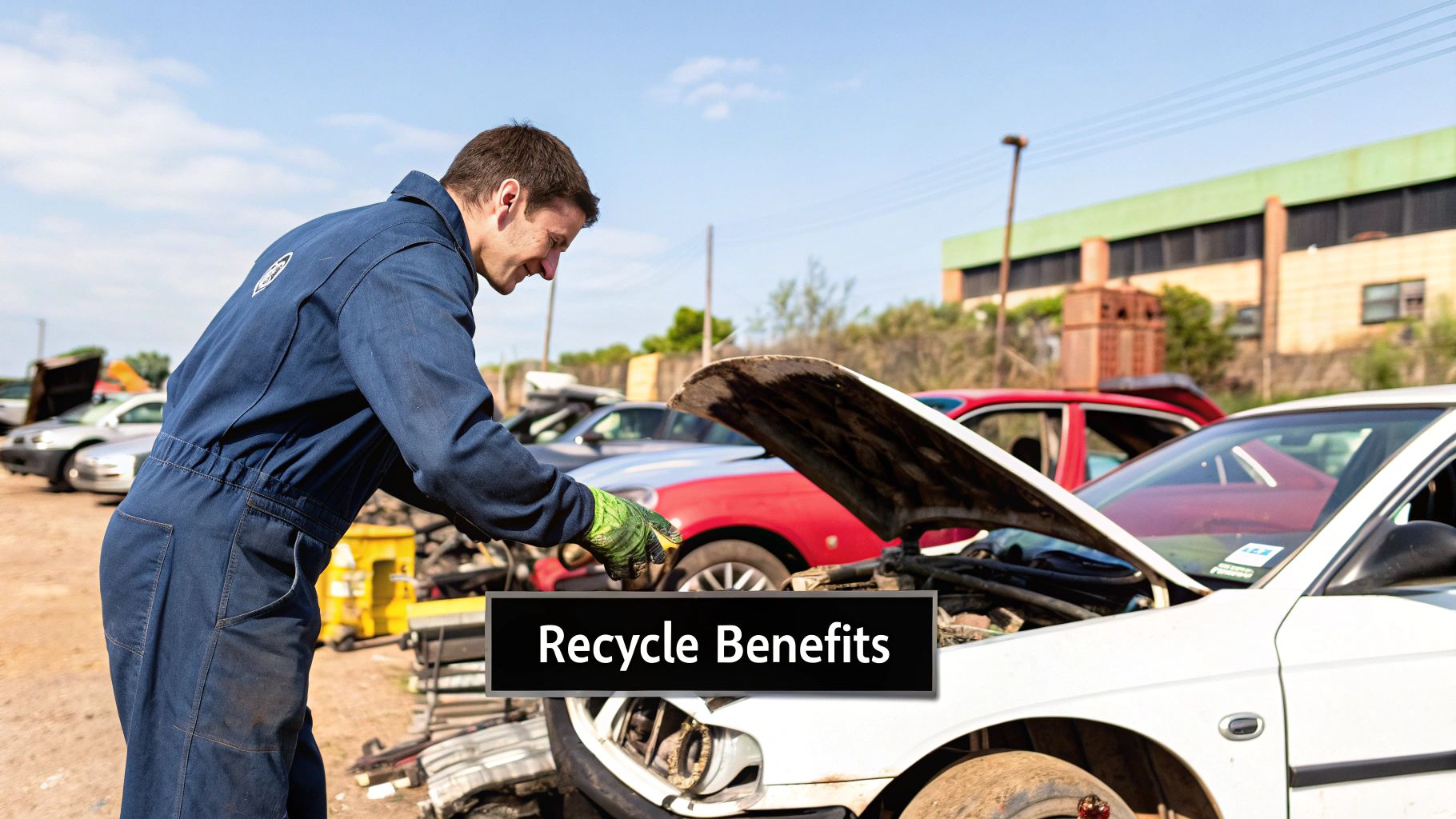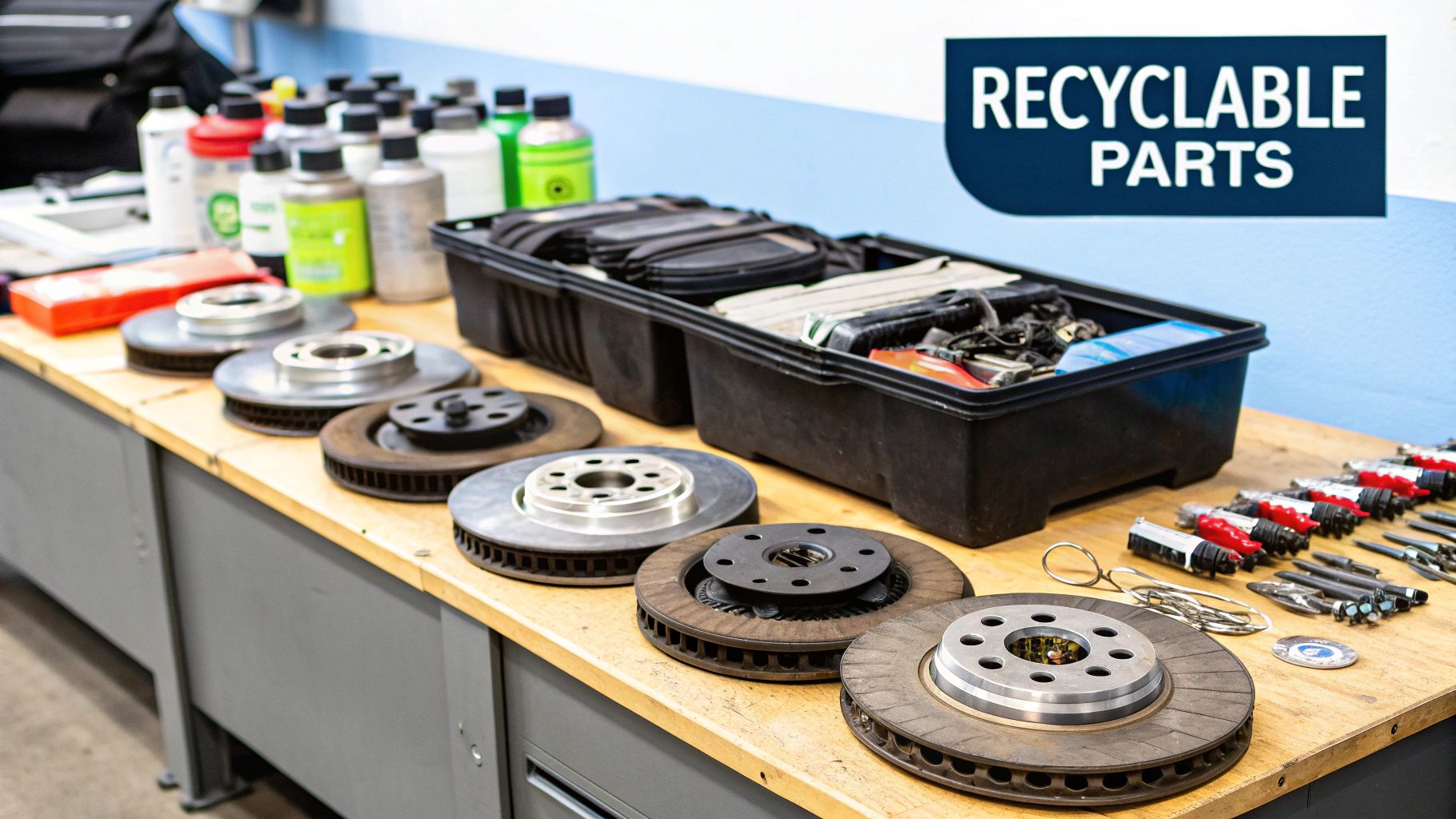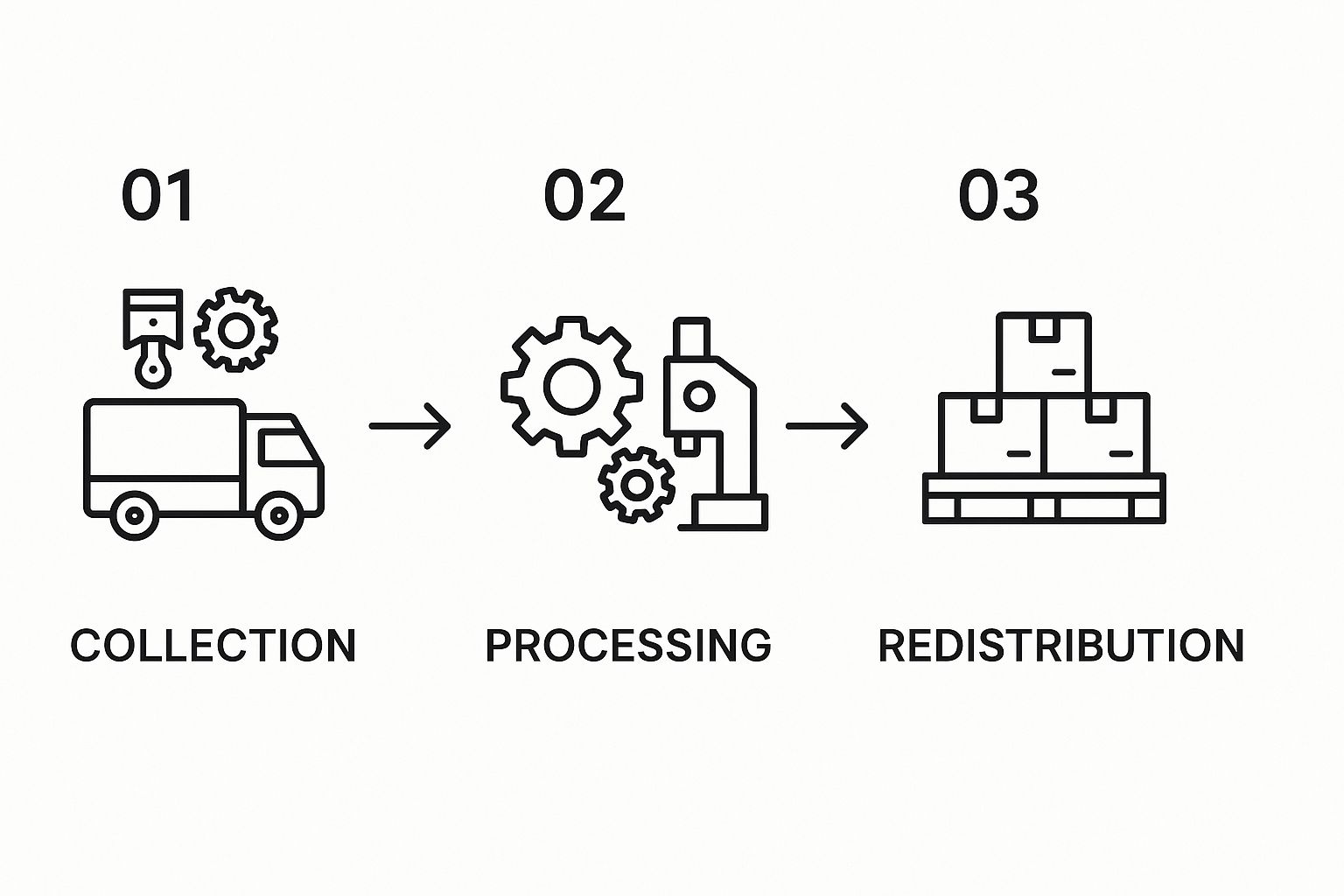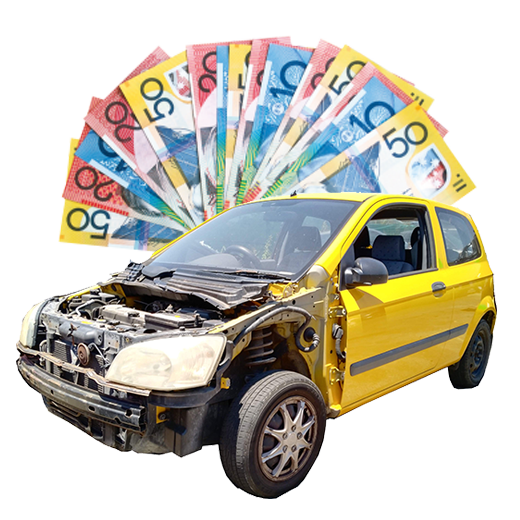That old car sitting in your driveway isn't just taking up space—it's a potential goldmine of valuable components waiting to be sold or recycled. If you’re willing to get your hands a little dirty, you can strategically dismantle your vehicle, pick out the high-demand items, and connect with the right buyers. It’s a great way to turn what looks like junk into a profitable and surprisingly eco-friendly project.
Why Bother Recycling Auto Parts?

Turning an old car into a collection of reusable parts is more than just a weekend project; it’s a smart move for your wallet and the environment. There's a huge demand for second-hand components from car owners looking for cheaper repair solutions, which creates a ready-made market for whatever you can salvage.
The economic argument is pretty compelling. Some recent research showed that Aussie drivers could save an average of $2,144 each over five years just by using recycled parts instead of brand-new ones. That adds up to a massive nationwide saving of about $15.5 billion—a clear sign of just how strong this market is.
The Real Perks of Part Recycling
Aside from the cash you can make, recycling car components has some other serious advantages that make the effort well worth it.
Here’s what you stand to gain:
- Maximise Your Payout: Selling individual parts almost always brings in more money than selling the whole car for its scrap metal weight. Big-ticket items like engines, transmissions, and catalytic converters can fetch hundreds of dollars on their own.
- Do Your Bit for the Planet: Reusing parts cuts down on the need for new manufacturing, a process that guzzles energy and raw materials. This directly helps lower the carbon footprint tied to producing new components from scratch.
- Support a Smarter System: When you recycle auto parts, you help keep valuable materials in use and out of our already-strained landfills. You can dive deeper into this with our guide to auto parts recycling.
Taking a car apart yourself gives you complete control over its final chapter. You get to ensure every usable component finds a new home and that any hazardous fluids are dealt with properly, preventing them from contaminating the environment.
Ultimately, this hands-on approach transforms a forgotten car from a passive liability into an active source of income and a genuine environmental win.
High-Value Parts to Prioritise for Recycling
If you're short on time, it pays to be strategic. Focus your efforts on these components first to maximise your cash return when you recycle auto parts.
| Part Category | Potential Value (Low to High) | Recycling Method |
|---|---|---|
| Engine & Transmission | $200 – $1,500+ | Sell to rebuilders, mechanics, or online marketplaces. |
| Catalytic Converter | $100 – $800+ | Sell to specialised recyclers for precious metal recovery. |
| Alternator & Starter | $30 – $150 | Often sold to auto electricians or part remanufacturers. |
| Wheels & Tyres | $50 – $400 (per set) | Sell to individuals, tyre shops, or scrap metal yards. |
| Radiator & Condenser | $20 – $100 | Sell to scrap metal dealers (aluminium/copper value). |
| Battery | $10 – $30 | Return to an auto parts store or a dedicated battery recycler. |
By targeting these high-demand items, you ensure your time and effort deliver the best possible financial outcome. Once these are out, you can decide whether to continue dismantling or send the rest of the shell to a scrap yard.
Setting Up Your Workspace for Safe Dismantling

Before you even think about grabbing a spanner, the most important job is setting up a safe and organised workspace. I’ve seen it a hundred times: a rushed setup leads to accidents or lost parts. Taking an hour to get your area prepped properly is non-negotiable before you start to recycle auto parts.
First things first, find a flat, stable surface. A concrete garage floor or a level driveway is ideal. Trying to work on a grassy slope or uneven ground is a nightmare, especially once you start jacking the car up or wrestling with heavy components. You also need good lighting and plenty of ventilation—this is especially true when you start draining fluids and dealing with fumes.
Handling Hazardous Fluids Safely
One of the first, and messiest, jobs is draining all the fluids. This stuff is nasty—it’s toxic to you and terrible for the environment. You can cop some pretty hefty fines for illegally dumping oil or coolant in Australia, so it’s just not worth the risk.
You’ll need to get a few different drain pans and sealable containers ready for the job.
- Engine Oil: Your standard oil drain pan is perfect for this.
- Coolant (Antifreeze): This is highly toxic, so you absolutely need a dedicated, clearly labelled container to store it in.
- Fuel: Use an approved fuel caddy or a proper jerry can designed for flammable liquids. Seriously, don't even think about using a regular bucket.
- Transmission & Brake Fluid: It's best to keep these separate as they often get recycled differently.
Once you’ve got everything drained, you need to take it to a proper disposal facility. Most local council recycling centres or auto shops like Supercheap Auto or Repco have services where you can drop off used fluids for free.
A quick word of warning from experience: Always, always work in a well-ventilated space when you're around fuel and chemical fumes. And never, ever drain fluids near an open flame, a heater, or anything else that could spark. It’s a simple check that can prevent a disaster.
Your Essential Toolkit
You don’t need to buy a professional workshop's worth of gear, but having the right tools makes the job infinitely easier and safer. A good-quality socket set, a beefy breaker bar for those seized bolts, and a set of solid, reliable jack stands are the bare minimum.
When it comes to pulling the big stuff like the engine or transmission, don't try to be a hero. Renting an engine hoist is the only safe and sensible way to handle that kind of weight.
How to Identify and Remove Valuable Auto Parts
Now that your workspace is ready, it's time to get your hands dirty. When you want to recycle auto parts for the best possible cash return, you need a plan. Don't just start yanking bits and pieces off at random—there's a method to the madness that will save you a ton of time and stop you from accidentally breaking something valuable. I always think of it like peeling an onion; you start with the easy, accessible outer layers first.
This isn't just about pulling a car apart. It's a process, moving from collecting the parts to getting them ready for someone else to use again.

The image above gives you a clear picture of how this works, showing the organised system that takes old parts and puts them back into circulation.
Kick things off with the high-value items that are easy to get to. The battery is a no-brainer. After that, go for the alternator, starter motor, and radiator. These are almost always right at the front or top of the engine bay, and you can usually have them out with basic tools in less than an hour.
Tackling the Major Components
Once you've stripped away those smaller bits, you’ll have a clear shot at the big-ticket items: the engine, transmission, and catalytic converter. These three are usually where the real money is, so you need to be careful not to damage them during removal. For the engine and transmission, an engine hoist isn't just a nice-to-have, it's essential for lifting them safely. Don't even think about trying it without one.
The catalytic converter is another goldmine because of the precious metals inside. You'll find it in the exhaust system under the car, which means you'll need to jack the vehicle up and get it securely on stands before you crawl underneath. The payout for these can vary wildly depending on the car model. It's a good idea to check out https://autoremovaladelaide.com.au/catalytic-converter-scrap-prices/ to get a realistic idea of what you might get.
Here's a personal tip that has saved me from countless headaches: get a bunch of zip-lock bags and a permanent marker. Every time you take a part off, put all of its bolts, nuts, and brackets into a bag and label it. It's a tiny step, but it makes the parts so much more appealing to a buyer who won't have to hunt for the right hardware.
Pro Tips for a Smooth Removal Process
The condition you keep the parts in while taking them off directly affects how much you can sell them for. A cracked casing or a stripped bolt can instantly turn a profitable part into worthless scrap metal.
Here are a few practical tips I’ve learned over the years:
- Take Photos as You Go: Before you unbolt anything, snap a few pictures with your phone. This gives you a visual reminder of how everything connects, which is a lifesaver when you can't remember where that one bracket went.
- Use Penetrating Oil: Got a rusty, stubborn bolt? Give it a good spray with a penetrating oil like WD-40 or RP7. Let it soak for ten minutes before you put a spanner on it again. You’ll be surprised at the difference it makes.
- Don't Cut Wires or Hoses: Try to avoid cutting anything unless there's absolutely no other way. Unplug electrical connectors and unclamp hoses properly. A complete wiring harness or an intact hose is always worth more than a chopped-up one.
Following a methodical approach like this makes sure you get the parts out efficiently and, more importantly, in a condition that people will actually want to buy.
Sorting and Selling Your Recycled Car Parts

Alright, you've got a pile of parts on the ground, and now it's time to turn that effort into actual cash. This is where the business side of the project kicks in, and it all starts with smart sorting. Don't just chuck everything into one big heap; organising your haul is the secret to getting the best price when you recycle auto parts.
A quick tip from experience: a simple wipe-down with a degreaser can make a massive difference. Clean parts just look more appealing to buyers and can help you justify a higher price. It’s a small bit of effort that signals the part has been looked after and usually gets it sold faster.
Creating Your Sales Piles
The best way to tackle this is to think of your collection in three distinct categories. Organising them this way makes it much clearer where to sell each item, so you're not leaving money on the table. It’s all about matching the part to the right kind of buyer.
Here’s a simple system that works well:
- High-Value Resale Parts: These are your money-makers—the functional, in-demand items like engines, transmissions, alternators, and starter motors. You'll want to sell these individually.
- Scrap Metal: This pile is for everything else made of metal that isn't worth selling on its own. It's a good idea to separate ferrous metals (steel, iron) from the non-ferrous ones (aluminium, copper), as they fetch different prices at the scrap yard.
- Specialty Items: Things like batteries and catalytic converters are a bit different. They need to be sold to specialised recyclers who are equipped to handle them properly.
Australia's automotive recycling industry is a pretty big deal for sustainability. Think about it: with over 20 million vehicles on our roads and about 500,000 of them hitting the end of the line each year, the industry manages to achieve a recycling rate of around 75%. That's a huge amount of material kept out of landfill.
Finding the Right Buyers
Once you've got your piles sorted, it's time to start selling. For your high-value parts, online marketplaces like eBay and Gumtree are fantastic. They give you access to a massive audience of DIY mechanics and car nuts all over the country. Once you've pulled a good part, you'll need to get it ready to send off, which means getting familiar with the ins and outs of shipping auto parts.
If you're looking for a faster, no-fuss sale, local auto wreckers are your best bet. They often buy parts in bulk and pay you on the spot, which is perfect if you just want to clear out your space. We've got more advice in our guide on selling your car to wreckers.
And for your scrap metal pile? Just take it down to a local scrap dealer. They'll weigh it and pay you right then and there. Easy as that.
Once you’ve stripped everything of value, you’re left with the car's bare metal skeleton. Dealing with this shell is the final, and most important, step in doing this whole process right. You can’t just let it rust in the backyard – that metal frame is still worth something.
Your next move is to find a good scrap metal recycler. These guys will buy the car body from you, and they usually pay by weight. The price for scrap steel goes up and down, but it’s an easy way to get one last payment for all your hard work. Just search for "scrap metal dealer" or "car wreckers" in your local area, and you'll find plenty of options.
Getting the Shell Ready for its Final Trip
Before you can get it hauled away, you've got a little bit of prep work to do. The scrap yard will want the shell as clean as possible, which means getting rid of any lingering non-metal bits.
Here’s what that usually looks like:
- Strip out any leftover plastics: This means any bits of the dashboard, door trims, or bumper pieces you might have missed.
- Do a final fluid check: Double-check that every last drop of oil, coolant, and fuel has been drained out of any lines or small reservoirs.
- Get your paperwork in order: You’ll almost certainly need proof of ownership, like the car’s title or registration papers, to legally sell the body for scrap. It proves the car is actually yours to sell.
The whole point of this exercise is to make sure as little of the vehicle as possible ends up as landfill. Every part you pull, and finally the shell you scrap, makes a real difference.
Closing the Loop on Car Recycling
Selling the car’s body for scrap is how you truly and responsibly recycle auto parts. It ensures the single biggest component of the car—its steel frame—gets melted down and turned into something new. This massively cuts down on the need to mine and process new raw materials.
And it’s a bigger deal than you might think, especially when you look at the numbers here in Australia. Every year, about 850,000 vehicles hit the end of the road, creating a massive 1.36 million tonnes of waste. While we manage to recycle around 70% of that, a huge amount still gets buried in the ground. If you want to dive deeper, you can read more about the path to better car recycling in Australia to see the full scale of the problem.
By making sure that final shell goes to a recycler, you’re helping to push that percentage up, one car at a time.
Got Questions? We've Got Answers
Even with a solid game plan, it's natural to have a few questions swirling around. Let's tackle some of the most common ones that pop up when people decide to recycle auto parts. Getting these cleared up from the start will help you sidestep common traps and get the best bang for your buck.
So, How Much Can I Actually Make from One Car?
This is the million-dollar question, isn't it? The honest answer is: it depends. The car's make, model, age, and what's still working under the bonnet all play a huge role. Big-ticket items like a running engine or a smooth transmission can easily fetch a few hundred dollars each.
Think of it this way: a good alternator might sell for $50-$150, while a catalytic converter, thanks to the precious metals inside, can be worth hundreds. Add in the scrap value of the car's shell, and you could be looking at anywhere from a few hundred to well over a thousand dollars for your efforts.
Do I Need a Special Licence to Sell Off Car Parts?
If you're just a private individual in Australia parting out your own car, you're generally in the clear. It's considered a private sale of your own goods, so no special licence is needed.
But here’s the important bit: if you start turning this into a regular gig and buying cars to part out, the game changes. You’ll almost certainly need to register as a business and might need a motor vehicle wrecker's licence, which varies by state. Always best to have a quick chat with your local council to be safe.
What are the Biggest Mistakes People Make?
I see the same few pitfalls trip people up time and time again, and they usually boil down to safety and simple oversights.
- Cutting corners on safety: Never, ever get under a car that isn't rock-solid on jack stands. It’s a huge risk that’s just not worth taking.
- Mishandling fluids: Simply dumping old oil, coolant, or brake fluid is a big no-no. It's terrible for the environment and can land you with a hefty fine.
- Poor presentation: A dirty, greasy part looks like junk. A clean part looks like a bargain. Taking 10 minutes to clean a component can dramatically increase what someone is willing to pay for it.
- Not doing your homework: The quickest way to get ripped off is by not knowing what your parts are worth. A quick search online will give you a ballpark figure, so you won't get lowballed by savvy buyers.
If dismantling your car sounds like a bigger job than you're up for, Auto Removal Adelaide can take care of it for you. We pay top cash for old, unwanted, and scrap cars and offer free removal right across Adelaide. Get a free quote today!


